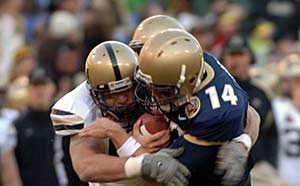Abstract
Playing sports can be a lot of fun, but some sports pose higher risks of concussions, or brain injuries resulting from collisions, especially in contact sports like football. Some coaches, teams, and players use new warning devices mounted on helmets that sound an alarm after the head receives a serious impact. This gives an advanced warning of concussion risk (possibly before any of the medical symptoms might appear), signaling that the player should stop playing and see a medical professional. In this sports science project, you will use "shock indicator" stickers mounted on helmets (or other headgear) to see what kind of impacts many athletes experience during typical practices or games.Summary
The information and data collected in this activity are for educational purposes only. For specific medical advice, diagnoses, and treatment, consult your doctor.
Because of these health and safety concerns, adult supervision is required for this project. Some science fairs may require prior approval from the Scientific Review Committee for this project, ask your teacher or fair coordinator for details.
Ben Finio, Ph.D., Science Buddies

Objective
Use shock indicators mounted on helmets to determine the level of impacts during a typical practice or game.
Introduction
Do you play or watch contact sports like football, lacrosse, rugby, soccer, hockey, or boxing? If so, you may have heard about the risk of concussions, technically referred to as mild traumatic brain injuries or MTBIs. According to the U.S. Centers for Disease Control and Prevention (or CDC), a concussion is "a type of traumatic brain injury, or TBI, caused by a bump, blow, or jolt to the head that can change the way your brain normally works. Concussions can also occur from a fall or a blow to the body that causes the head and brain to move quickly back and forth." Recently, scientists along with athletes at all levels, coaches and parents, have been trying to determine what the long term effects of a concussion are, how to diagnose them, treat them, and prevent them. In this science project you can do some of your own research on the topic.
Concussion Risks and Symptoms
The exact short-term symptoms and long-term effects, as well as how to diagnose and treat a concussion, are still an active area of medical research. In general, short-term signs of a concussion can include nausea, headaches, memory loss, trouble focusing, mood changes, sleep problems, and more. Long-term effects can include (but are not limited to) serious problems like difficulty speaking, sensory loss (hearing, taste, or vision) or psychological outcomes like depression and anxiety. See the references in the Bibliography section for more information about what doctors and scientists are learning about the short and long-term effects of concussions.
Contact sports that result in high-speed collisions and tackles between players, like football (Figure 1), pose a particularly high risk for concussions. Research suggests that playing such contact sports can be especially risky because repeated concussions over a long period of time (months or years) can cause serious brain damage. As a result, the CDC and other health organizations recommend that a player who shows any signs of a concussion be immediately removed from play and see a health-care professional. In 2013, former National Football League players won a lawsuit against the NFL, alleging that the NFL downplayed the dangers of repeated concussions, encouraging injured players to return to the field to keep playing — resulting in serious long-term health consequences (see the Bibliography to read more about the lawsuit).
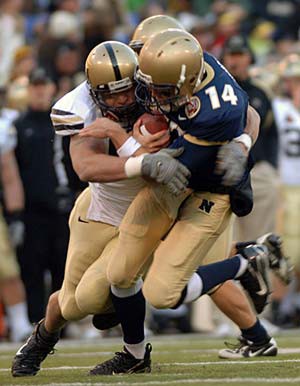 Image Credit: US Navy / Public domain
Image Credit: US Navy / Public domain
Figure 1. Contact sports like football pose an increased concussion risk, even though the players wear protective helmets. (Image courtesy of the U.S. Navy.)
Because health experts recommend that players who have experienced a concussion be removed from the game right away, it is increasingly important to detect concussions as quickly as possible. However, it can be difficult to detect a concussion because even some of the short-term physical symptoms, like nausea or dizziness, might not appear for several hours or even days after the impact. As a result, some players, coaches, and teams have started to use impact-sensing devices mounted on helmets that give off a warning (such as a flashing light) when a player receives a very severe hit that may require medical attention. This can let players and coaches know that a player should probably be taken out of the game — even if no visible signs of a concussion are present — to see the team medical staff or a doctor and avoid the risk of another concussion. It is important to note, however, that these impact-sensing devices do not replace a medical diagnosis by a doctor. Just because the warning goes off does not guarantee that a player has a concussion, and it could be possible for a player to get a concussion without the warning going off (see the Wired.com article in the Bibliography for more information). Concussions in sports is a very active area of research and debate with new opinions and data being released frequently. For this reason, it is particularly important to do a thorough job of background research before starting your science project.
In this sports science project, you will use shock indicators mounted on helmets to measure how often players experience impacts above a certain threshold during a typical practice or game (if you choose a sport that does not require a helmet, like soccer or rugby, you will have to ask the players to wear hats or headbands). But, before you can do that, you will need to understand the physics behind what occurs during a concussion.
The Physics of a Concussion
So, what actually happens to a person's brain during a concussion? The brain is cushioned from everyday bumps and knocks by the cerebrospinal fluid that it floats in, inside the skull. However, this fluid can only prevent so much damage — a sharp blow to somebody's head, neck, or upper body can cause the brain to strike the inside of the skull, causing a concussion. Figure 2 shows a diagram of what happens inside the skull during a sharp impact.
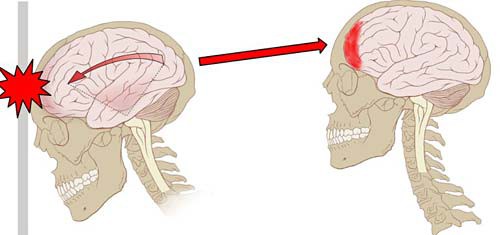 Image Credit: Wikimedia Commons user Max Andrews / Creative Commons Attribution-Share Alike 3.0 Unported
Image Credit: Wikimedia Commons user Max Andrews / Creative Commons Attribution-Share Alike 3.0 Unported
Figure 2. Rapid motions or impacts to the head can cause the brain to collide with the inside walls of the skull, resulting in a concussion. (image courtesy of Wikimedia Commons user Max Andrews, 2012)
So, how do scientists, engineers, and doctors measure a "sharp impact" to determine if there is a risk of concussion? They do this by measuring acceleration. Acceleration is a measure of how fast something speeds up or slows down. Something that is speeding up has a positive acceleration, and something that is slowing down has a negative acceleration (also referred to as deceleration). For example, a car that gradually speeds up after a stop sign has a low acceleration. A car that slams on the gas pedal has a high acceleration.
With head impacts, a high acceleration (either positive or negative) means a greater risk that the brain has struck the inside of the skull. In this science project, you will measure acceleration in terms of gravitational acceleration (how fast something speeds up when it falls), which is simply referred to as g. On Earth, gravitational acceleration has a value of 9.81 meters per second squared (m/s2). An acceleration of 1 g is equal to the Earth's gravitational acceleration, or 9.81 m/s2. An acceleration of 10 g is ten times that amount, or 98.1 m/s2.
Many different studies have measured the acceleration of impacts in contact sports, in an attempt to find a "concussion threshold." For a detailed discussion, see the article "Biomechanics of Sport Concussion: Quest for the Elusive Injury Threshold," listed in the Bibliography. In general, typical impacts (those that do not result in concussions) for high-impact sports can be in the range of 25–35 g. Some studies have found a concussion threshold around 70–90 g, whereas others found that players can suffer a concussion in a wider range of accelerations, with accelerations as low as 60 g sometimes causing a concussion, and accelerations over 100 g sometimes not causing a concussion. That is why the authors of the article refer to the concussion threshold has "elusive" — its boundaries are not clearly defined.
In this science project, you will mount indicators on helmets that detect two different acceleration thresholds (for example, 25 g and 50 g), roughly representing "typical" and "hard" hits, respectively, on players' helmets for practices or games. Remember that they do not represent "no concussion" and "concussion", because the concussion impact threshold is not clearly defined. They just give you a general idea of the severity of hits that the players receive, and if there may be increased risk of concussion. You will record how many players experience at least one typical or at least one hard hit during a normal game or practice. How often do you think players will experience hits at the lower threshold? How often do you think players will experience hits at the higher threshold? For example, if your team practices every day after school (five days a week), do you think a typical player will experience at least one hard hit every day, or is that something that happens only rarely?
Important safety note: Even if an impact indicator does not go off, it does not mean a player has not suffered a concussion. Never rely solely on impact indicators for a medical diagnosis. A player who shows any sign of a concussion should leave the field and seek professional medical attention. See the Concussion in Sports reference from the CDC in the Bibliography for warning signs that coaches and athletes can detect.
Terms and Concepts
- Concussion
- Mild traumatic brain injury (MTBI)
- Acceleration
- g (acceleration due to gravity)
Questions
- What is a concussion? How do concussions happen, and what happens to the brain during a concussion?
- What are some of the short- and long-term consequences of a concussion? What are they for repeated concussions?
- What is acceleration? What range of impact accelerations might a player experience during contact sports?
- Is there a well-defined "threshold" for impact accelerations above which a concussion will occur?
Bibliography
Here are some medical resources about concussions:
- Mayo Clinic staff. (2011, February 22). Concussion. Mayo Clinic. Retrieved December 10, 2013.
- National Center for Injury Prevention and Control. (2013, August 15). Concussion and mild TBI. Centers for Disease Control and Prevention. Retrieved December 10, 2013.
- National Center for Injury Prevention and Control. (2009, December 8). Concussion in sports. Centers for Disease Control and Prevention. Retrieved December 16, 2013.
- # Link Name="Sports_p063.4" Value="HtmlAnchor" HtmlText="KidsHealth.org" #]. (2011, January). Concussions. The Nemours Foundation. Retrieved December 12, 2013.
Here is an article about the lawsuit between former NFL players and the NFL:
- Associated Press. (2013, August 29). NFL, ex-players agree to $765M settlement in concussions suit. Retrieved December 10, 2013.
The following article describes a new technology for making football helmets that protect players better from blows at any angle of impact:
- Liston, B. (2014, January 8). Florida researchers developing football helmets to reduce concussions. Thomson Reuters. Retrieved January 9, 2014.
This article discusses some commercially available impact-sensing devices and the controversy surrounding their use:
- Stack, K. (2012, March 26). Concussion-sensing chin strap raises questions. Wired.com. Retrieved December 10, 2013.
This publication discusses the search for an "injury threshold," an acceleration above which concussions are very likely to occur:
- Guskiewicz, Kevin M., and Jason P. Mihalik. "Biomechanics of sport concussion: Quest for the elusive injury threshold." Exercise and Sports Sciences Reviews 39, January 2011: 4-11. Retrieved December 10, 2013.
Materials and Equipment
- Resettable shock indicators (20 total, 10 each of two different thresholds), available from
Telatemp. You only need 9 of each type (18 total) for this project, but the minimum order quantity is 10. So you will have extras in case one breaks.
- The thresholds of the shock indicators you use will depend on the sport you plan to observe for your experiment and the age of the athletes. For example, high-school football players will probably experience higher accelerations than middle-school soccer players.
- For high-impact sports, such as football, ice hockey, rugby, and lacrosse (all for high-school athletes), you should order:
- For lower-impact sports, such as soccer and field hockey (for middle-school athletes), you should order:
- Optional: You can also purchase 100 g resettable shock indicators to test very high impacts.
- Note: Each individual shock indicator can only be reset a total of ten times. If you would like to collect additional data (over a longer period of time), you can purchase more shock indicators, but this will add to the project cost.
- Volunteers (3) who play a contact sport and who have permission from their parents and coaches to wear the resettable shock indicators during practices or games.
- You will mount three shock indicators of each type, for a total of six, on each helmet. This means that 10 indicators of each type, or a total of 20, will be enough to test up to three volunteers (with one of each type left over for spares).
- If you would like to test more volunteers (for example, an entire team), you can purchase more shock indicators, but this will add to the project cost.
- Coordinate with the players and coaches to determine when you will do your tests (see Procedure section for details).
- Pick players who will typically experience hard tackles or hits during the game. For example, if your volunteers play football, a linebacker or running back would be better choices than the punter or kicker.
- Optional: If the sport you choose does not use helmets, you will need another way to attach the shock indicators to the players' heads — for example, hats or headbands.
- Needle or pin to reset the shock indicators
- Lab notebook
Disclaimer: Science Buddies participates in affiliate programs with Home Science Tools, Amazon.com, Carolina Biological, and Jameco Electronics. Proceeds from the affiliate programs help support Science Buddies, a 501(c)(3) public charity, and keep our resources free for everyone. Our top priority is student learning. If you have any comments (positive or negative) related to purchases you've made for science projects from recommendations on our site, please let us know. Write to us at scibuddy@sciencebuddies.org.
Experimental Procedure
Working with Human Test Subjects
There are special considerations when designing an experiment involving human subjects. Fairs affiliated with Regeneron International Science and Engineering Fair (ISEF) often require an Informed Consent Form (permission sheet) for every participant who is questioned. Consult the rules and regulations of the science fair that you are entering, prior to performing experiments or surveys. Please refer to the Science Buddies documents Projects Involving Human Subjects and Scientific Review Committee for additional important requirements. If you are working with minors, you must get advance permission from the children's parents or guardians (and teachers if you are performing the test while they are in school) to make sure that it is all right for the children to participate in the science fair project. Here are suggested guidelines for obtaining permission for working with minors:
- Write a clear description of your science fair project, what you are studying, and what you hope to learn. Include how the child will be tested. Include a paragraph where you get a parent's or guardian's and/or teacher's signature.
- Print out as many copies as you need for each child you will be surveying.
- Pass out the permission sheet to the children or to the teachers of the children to give to the parents. You must have permission for all the children in order to be able to use them as test subjects.
Note: This procedure will use 25 g and 50 g shock indicators as an example. Remember that if you are doing this project for a lower-impact sport or for younger athletes, you may use shock indicators with lower thresholds, as described in the Materials section.
Make a Data Collection Plan
- Come up with a data collection plan that fits the practice or game schedule of your volunteers. Your goal is to measure how many of your volunteers experience at least one hit above a certain acceleration threshold (for example, 25 g or 50 g) during a certain time period. Each individual shock indicator can be reset up to ten times, so you can collect up to ten data points for each volunteer. Following are some sample data collection plans; remember, however, that you will need to discuss your plan with your volunteers and their coaches.
- If your volunteers practice after school every day (five days a week), you could have them wear the shock indicators for two full weeks of practice (ten practices total). You will reset the shock indicators before each practice starts. At the end of each practice, you will record whether any of the shock indicators have gone off for each volunteer. Alternatively, you could only collect data for one week, but reset the shock indicators halfway through each practice.
- If your volunteers will be playing a game broken into different periods (halves, quarters, etc.), you could have them wear the shock indicators for a few games, for a total of ten periods. After each period, record whether any shock indicators have gone off for each volunteer, and reset them for the next period.
- Note: Each shock indicator can only detect one hit above its threshold before it needs to be reset. This means that, for example, if a shock indicator goes off in the first minute of an hour-long game, you have no way of knowing if the player experienced additional hits above the threshold for the remainder of the game. This is a limitation of the approach used in this science project — it only tells you if a player experienced at least one hit above a threshold (but not how many beyond that). If you would like to build a more advanced impact-sensing device that can record every single hit, see the Make It Your Own section.
- Once you have come up with a data collection plan, make a data table that will be easy to record your results in. Table 1 is an example data table for the plan listed in step 1a above. For each practice, you will be marking "yes" or "no" in the 25 g and 50 g rows for each volunteer, depending on whether at least one of the indicators for that level has gone off.
| Practice # | Indicator Type | Volunteer 1 | Volunteer 2 | Volunteer 3 |
| 1 | 25 g | |||
| 50 g | ||||
| 2 | 25 g | |||
| 50 g | ||||
| 3 | 25 g | |||
| 50 g | ||||
| 4 | 25 g | |||
| 50 g | ||||
| Etc. ... | Etc. ... |
Table 1. A sample data table to record whether at least one of the 25 g or 50 g shock indicators goes off during different practices.
Mount the Shock Indicators on the Helmets
Note: This section uses football helmets and 25 g and 50 g shock indicators as examples. You may need to adapt your procedure for a different sport. Remember that if your sport does not use helmets at all, you will still need to figure out a way to mount the shock indicators to your volunteers' heads — for example, using headbands or hats. Ask an adult if you need help.
- Before you start, familiarize yourself with the shock indicators. The shock indicators are small red plastic labels with two arrows pointing in opposite directions. Each indicator can only measure shock along the direction the arrows are pointing.
- When the shock indicator "goes off," meaning it experienced an impact above the labeled threshold, one or both of the arrows will turn dark blue, as shown in Figure 3.
- Whether both, or only one, of the arrows turn dark blue, depends on the nature of the impact. An impact that involves a sudden start and stop will probably set off both arrows. An impact that has a very slow start and then a sharp stop (for example, a player who falls, but then hits his head on the ground), or vice versa, may only set off one arrow.
- After it has gone off, a shock indicator can be reset by using a needle or pin to push a tiny button on the side. This has to be done for each arrow (see Figure 4) that turned blue. You will need to do this later when you collect your data.
- The shock indicators have a sticky tape backing that enables you to attach them to surfaces. Peeling off the protective plastic coating exposes the sticky backing (Figure 5). You will need to do this when you mount the indicators on the helmets.
- When the shock indicator "goes off," meaning it experienced an impact above the labeled threshold, one or both of the arrows will turn dark blue, as shown in Figure 3.
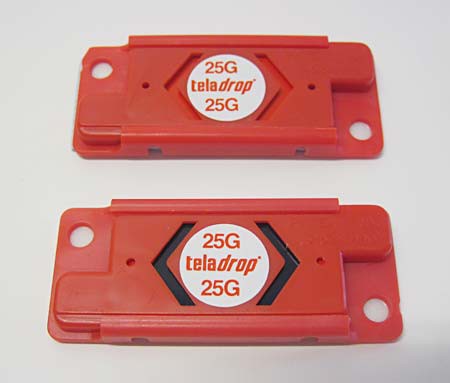 Image Credit: Ben Finio, Science Buddies / Science Buddies
Image Credit: Ben Finio, Science Buddies / Science Buddies
Figure 3. Resettable shock indicators. In this picture, the top indicator has not yet gone off, and the arrows appear red. The bottom indicator has gone off, and both arrows appear dark blue. An indicator still goes off if only one of the arrows appears dark blue.
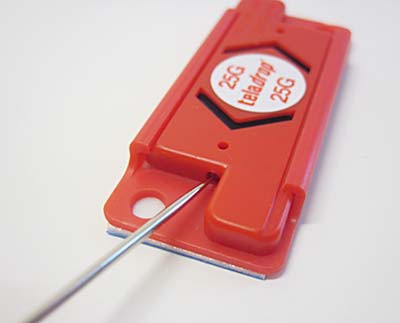 Image Credit: Ben Finio, Science Buddies / Science Buddies
Image Credit: Ben Finio, Science Buddies / Science Buddies
Figure 4. When a shock indicator has gone off and shows a blue arrow, you can use a pin to press in the tiny button on the side and reset the arrow to red.
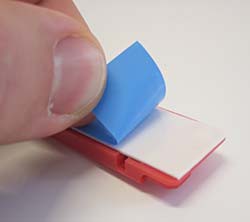 Image Credit: Ben Finio, Science Buddies / Science Buddies
Image Credit: Ben Finio, Science Buddies / Science Buddies
Figure 5. A protective plastic layer (blue) covers the adhesive backing (white) on the shock indicators.
- Determine how you want to mount the shock indicators and then mount them. You need to mount three of each type of shock indicator (six total) to each helmet. You must mount the shock indicators perpendicular to each other, so you can detect shocks in three different directions: forward/backward, left/right, and up/down. You can mount the indicators either on the outside of the helmet (which is discussed in step 2a), or on the inside of the helmet (which is discussed in step 2b). Each method has advantages and disadvantages — decide which one will work best for the type of helmets and the sport you have chosen for your experiment. Ask your coach or an adult if you need help figuring this part out.
- Mounting the indicators outside the helmet. Mounting the shock indicators on the outside of the helmet has the advantage of making it easy to access and reset the indicators. However, because the indicators are exposed, they risk being crushed or knocked off the helmet during play.
- If you decide to mount the indicators on the outside of the helmet, mount them in a configuration similar to what is shown in Figure 6. You do not need to follow this configuration exactly, as long as one indicator faces up/down, one faces left/right, and one faces forward/back.
- Figure 6 only shows 25 g shock indicators. Repeat step 2a to mount three 50 g shock indicators on the helmet next to the 25 g indicators, for a total of six shock indicators.
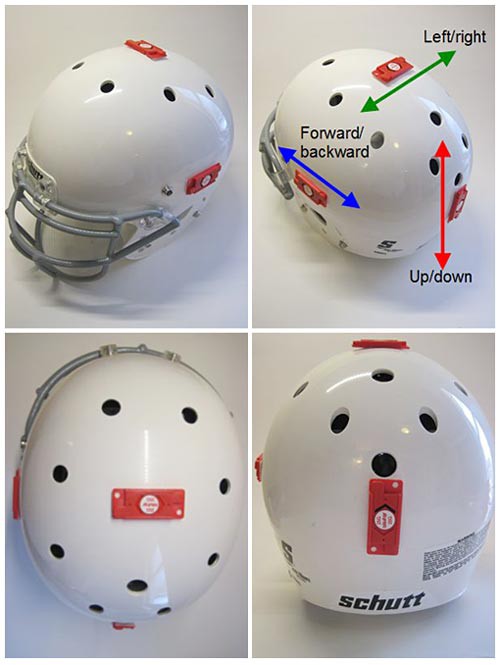 Image Credit: Ben Finio, Science Buddies / Science Buddies
Image Credit: Ben Finio, Science Buddies / Science Buddies
Figure 6. Several different camera views show three 25 g shock indicators mounted on a football helmet, in directions that are perpendicular to each other. This configuration makes the indicators easier to reset, but more susceptible to damage.
- Mounting the indicators inside the helmet. This has the advantage of protecting the shock indicators from being crushed or knocked off the helmet during play, but they may be harder to access and reset.
- If you decide to mount the indicators on the inside of the helmet, mount them in a configuration similar to what is shown in Figure 7. You do not need to follow this configuration exactly, as long as one indicator faces up/down, one faces left/right, and one faces forward/back.
- Figure 7 only shows 25 g shock indicators. Repeat step 2b to mount three 50 g shock indicators in the helmet next to the 25 g indicators, for a total of six shock indicators.
- Mounting the indicators outside the helmet. Mounting the shock indicators on the outside of the helmet has the advantage of making it easy to access and reset the indicators. However, because the indicators are exposed, they risk being crushed or knocked off the helmet during play.
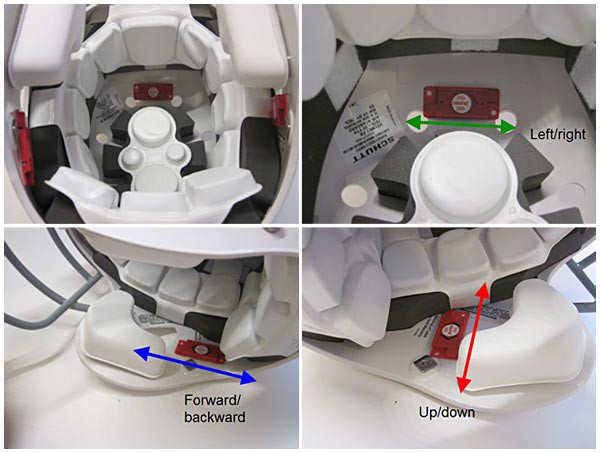 Image Credit: Ben Finio, Science Buddies / Science Buddies
Image Credit: Ben Finio, Science Buddies / Science Buddies
Figure 7. Several different camera views show three 25 g shock indicators mounted inside a football helmet, in directions that are perpendicular to each other. This configuration makes the indicators less susceptible to damage, but harder to reset.
- Repeat step 2 for the other two helmets. Do your best to use the same mounting method for all three helmets.
- Note: mounting three sensors at 90° angles to each other in this manner can give you a rough idea of how hard a player has been hit. However, it does not always work perfectly — for example, a 25 g hit at a 45° angle between two of the shock indicators would not set them off. This is a limitation of using shock indicators. In order to detect hits at any angle, you need to use an electronic device called an accelerometer. See the Make It Your Own section for more information.
Collect and Analyze Your Data
Important Safety Reminder: Remember that the purpose of this experiment is to measure head accelerations experienced during the course of normal play. Do not encourage your volunteers to hit each other extra hard during your experiment, and do not ask them to hit each other in the head. Direct head impacts are dangerous and can result in serious injury.
- Before your volunteers' first practice (or first period of the game), make sure all of the shock indicators are reset on each helmet. Some of the shock indicators may have gone off accidentally during shipping or handling.
- After practice (or the first period) is over, inspect all three of your volunteers' helmets. Use the data table you created to record whether at least one shock indicator of each type (25 g and 50 g) has gone off for each volunteer (by writing "yes" or "no" for that volunteer and indicator threshold).
- Remember that each indicator has two arrows. An indicator has gone off if one or both of the arrows has turned blue.
- Keep in mind that if an indicator has gone off, this means that the player received at least one impact above the acceleration threshold from that particular direction, because the indicators remain off after an impact and do not reset themselves automatically.
- Repeat steps 1 and 2 for each remaining practice (or period), until you have filled out your entire data table. Always remember to double-check that the shock indicators have been reset immediately before the next practice (or period).
- Calculate the percentage of practices (or periods) where each type of indicator (25 g or 50 g) has gone off for each volunteer.
- For example, if the 25 g indicator for Volunteer 1 has gone off in eight out of ten practices, then it has gone off 80% of the time because 8/10 = 0.8.
- Note: This tells you that the volunteer experienced at least one 25 g hit in 80% of the practices. Remember, because each impact indicator can only register one hit before it needs to be reset, it does not tell you how many total hits a volunteer received or how many of them were over 25 g. Be sure to interpret your data correctly!
- Record your results in a new data table like Table 2.
- For example, if the 25 g indicator for Volunteer 1 has gone off in eight out of ten practices, then it has gone off 80% of the time because 8/10 = 0.8.
| Volunteer Name | % of practices where 25 g indicator went off | % of practices where 50 g indicator went off |
| Volunteer 1 | ||
| Volunteer 2 | ||
| Volunteer 3 |
- Make a bar graph with practice (or period) number on the x-axis (horizontal axis), and the total number of volunteers with indicators that have gone off (1, 2, or 3) on the y-axis (vertical axis). Use one set of bars for the 25 g indicator and one set of bars for the 50 g indicator.
- Analyze your results.
- How do your results compare among volunteers? Were some players consistently hit harder than others? Does this have anything to do with the different positions that the volunteers play, or other factors?
- Do your results vary between practices (or periods), or are they consistent? Were players hit harder during certain times, and could any real-world conditions account for this (for example, an "easy" practice the day before a big game, or volunteers playing more intensely during the final quarter of a football game)?
- How do your results compare between the two types of shock indicators? Did you register more 25 g hits or 50 g hits?
- Important: Remember that the shock indicator will go off after any acceleration above its threshold. For example, a 55 g hit will make both the 50 g and 25 g shock indicators go off. So, any hit that makes a 50 g indicator go off should also make a 25 g indicator go off. Is it actually possible in this experiment to distinguish between a single 50 g hit, versus one 50 g hit and one 25 g hit?
Ask an Expert
Global Connections
The United Nations Sustainable Development Goals (UNSDGs) are a blueprint to achieve a better and more sustainable future for all.
Variations
- Can you use shock indicators with even higher thresholds (for example, 100 g) to detect even harder hits? What about lower-threshold indicators to detect light hits? Do some more background research about the range of accelerations associated with concussions, and use that research to help plan your experiment.
- The single-directional shock indicators used in this science project can only detect accelerations in a single direction. In theory, a player could receive a 25 g hit at a 45° angle between the front/back and left/right indicators, and this would not make either indicator go off. Can you think of a way to account for this? What about multidirectional shock indicators?
- In this project you only kept track of whether any of the shock indicators have gone off. You did not individually keep track of how often the front/back, left/right, or up/down directions had gone off. Can you keep track of which indicators go off? Do some directions tend to go off more than others? Do some more background research about concussions. Is there any known correlation between concussions and the direction of an impact to the head?
- Can you design a circuit using accelerometers and a microcontroller (like an Arduino) to keep track of the direction and magnitude of every hit received by a player during a game? Can you make the circuit sound an alarm or flash an LED when a certain threshold is exceeded?
- The indicators used in this science project measure translational acceleration (motion in a straight line). However, researchers have shown that rotational acceleration (spinning in a circle) also plays a role in concussions. Can you devise an experiment that also measures rotational accelerations?
- What happens if you attach shock indicators to other parts of the body (using appropriate protective gear like pads, gloves, shin guards, etc., as necessary)? What accelerations do these body parts experience? Do high accelerations elsewhere on the body correlate to other injuries, like sprains, bruises, or broken bones?
- Can you use shock indicators to compare the severity of typical impacts received by players in different positions? Do some players typically get hit harder than others?
- What other sports-related projects could you use the shock indicators for? For example, can you attach them to a ball to see how hard the ball is hit, kicked, or thrown?
Careers
If you like this project, you might enjoy exploring these related careers:
Related Links
- Science Fair Project Guide
- Other Ideas Like This
- Sports Science Project Ideas
- Human Biology & Health Project Ideas
- My Favorites


